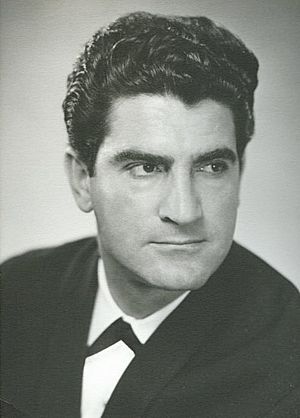Viguen facts for kids
Quick facts for kids
Viguen
|
|
|---|---|
 |
|
| Background information | |
| Birth name | Viguen Derderian |
| Born | 23 November 1929 Hamadan, Iran |
| Died | 26 October 2003 (aged 73) Los Angeles, California, United States |
| Genres | Rock Pop Jazz |
| Occupation(s) | Singer, actor |
| Instruments | Vocals, guitar |
| Years active | 1951–2001 |
| Labels | Avang Records, Caltex Records, Pars Video, Taraneh Enterprises Inc, |
Viguen (born Viguen Derderian, 23 November 1929 – 26 October 2003) was a famous Iranian pop music singer and actor. People called him the "King of Iranian pop" and the "Sultan of Jazz." He was very well known across the Near East. Viguen sang songs in both Persian and Armenian languages.
Viguen was from an Iranian-Armenian family. During the 1970s, which was a great time for Persian pop music, many famous Iranian singers looked up to him. His new and lively music style helped create a new kind of Iranian music. This new style was inspired by music from Western Europe and Latin America. Viguen's amazing singing and acting skills quickly caught the eye of important Iranian writers and composers. Together, they made some of Iran's most remembered songs.
Contents
Viguen's Early Life
Viguen was born in Hamadan, a city in western Iran. He was one of eight children in his family. When Viguen was only eight years old, his father passed away. His mother and older brother, Zaven, then raised him. His older brother, Karo, was a well-known Iranian poet. Karo wrote the words for Viguen's famous song, "Lala'ee" (which means Lullaby).
During World War II, Viguen's family moved to Tabriz in northern Iran. This is where Viguen bought his very first guitar from a Russian soldier. He loved American, Italian, and Spanish music. He often used these melodies for his songs, adding Persian words. These songs became some of Iran's most popular music.
Becoming a Star
When Viguen was in his mid-teens, he moved to Tehran. In 1951, he got a job singing at the Café Shemiran. This was a fancy restaurant and bar on the edge of the capital city.
Some fans in Iran compared Viguen to Elvis Presley. His good looks and strong build made him very popular. He was Iran's first male pop star. Young Iranian women especially liked him during the 1950s and 60s, when new ideas about freedom were growing. Viguen was also one of the first Iranian entertainers to play the guitar while performing.
Later Career and Songs
Viguen moved to the United States in 1971 and settled in California. He would visit Iran every year to perform concerts. After the Islamic Revolution of 1979, pop music was no longer allowed in Iran. Because of this, Viguen stayed in the United States. In February 2001, he celebrated 50 years of his music career. This special event took place at the Hollywood Palladium in Los Angeles.
Viguen recorded more than 600 songs during his long career. Some of his most famous songs include "Baroon Barooneh" (It's Raining), "Mahtab" (Moonlight), "Lala'ee" (Lullaby), and "Gol-e Sorkh" (Red Rose).
Viguen's Acting Career
Viguen started acting in movies in 1955. A famous Armenian-Iranian director named Samuel Khachikian discovered him. Viguen got a role in Khachikian's film "Chaharrah-e Havades" (Crossroads of Incidents). Over the years, he acted in many other movies. Some of these films were "Zalembala" (1956), "Tappeh-eh Eshgh" (1959), and "Arooseh Darya" (1965). He even started his own movie company called "Viguen Film," but he did not continue with it for long.
Movies Viguen Acted In
| Year | Original film title | English film title / translation | Notes |
|---|---|---|---|
| 1955 | Chaharrah-e Havades | The Crossroad of Events | This was Viguen's first movie role. |
| 1955 | Khoon va Sharaf | Blood and Honor | |
| 1959 | Tappe-ye Eshq | The Hill of Love | |
| 1965 | Aroos-e Darya | The Bride of the Sea | |
| 1969 | Atash va khakestar | Fire and Ashes |
Viguen's Family Life
Viguen was married three times. His first wife was Olga. They had three daughters: Aylin (who also became an actress), Jaklin Munns (a singer), and Katrin. His second wife was Nadia. They had a daughter named Evelyn and a son named Edwin. His third wife was Karen Holston Derderian. He also had a step-daughter named Robin.
Viguen's Passing
Viguen passed away at his home on 26 October 2003, after battling cancer. He was buried at Pierce Brothers Valley Oaks Cemetery in Westlake Village, California. By the time he passed away, he had recorded over six hundred songs. He also starred in six movies and appeared as a guest on popular TV shows. These shows included The Bob Hope Show, The Jack Benny Show, and Mission Impossible.
See also
 In Spanish: Viguen para niños
In Spanish: Viguen para niños

